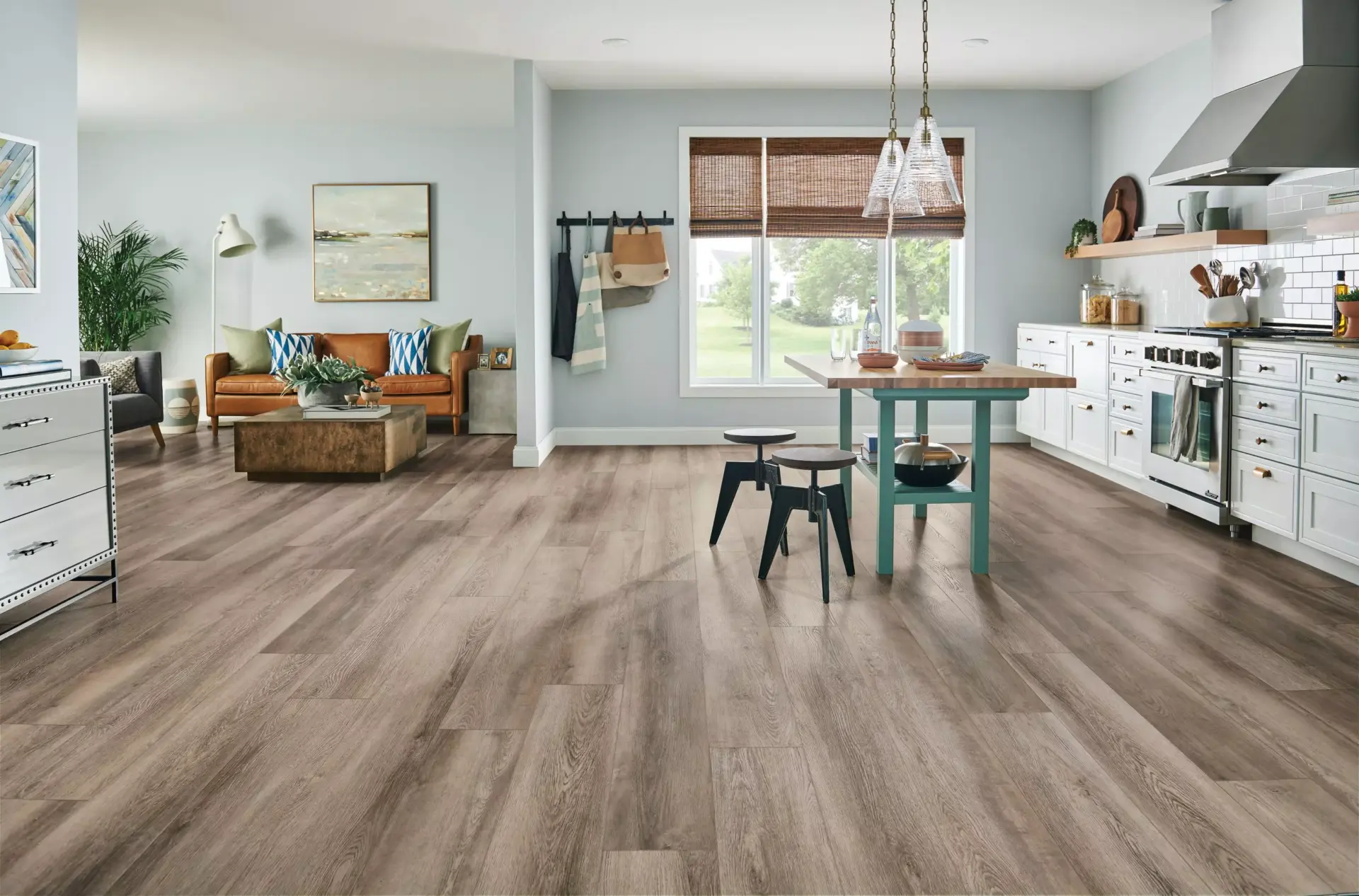Eco friendly flooring are great options for several reasons, the main ones being the health of residents and preservation of the environment.
Over the past five years, searches for sustainable goods have risen by 71% This is according to new research from the Economist Intelligence Unit (EIU).
The drive for sustainability goes beyond everyday purchases into larger items. This includes your flooring.
Great flooring should be durable, beautiful, and sustainable. But with all the eco-friendly flooring options out there, how do you know which one is right for you?
Luckily, this guide will break down everything you need to know about sustainable flooring and how you can find the perfect option for you and your family.
What Makes Eco Friendly Flooring Sustainable?
There are a few factors that go into making flooring options “sustainable.” First, you need to consider what materials make up your floors. Sustainable floors are generally constructed from renewable or natural resources.
The materials that make up your flooring should also come from an ethical source. A few questions that you can ask to determine this include:
- Are materials sustainably sourced?
- Do they come from recycled or reclaimed materials?
- Where do the materials come from and who collected them?
Another thing to consider is the lifespan of your flooring. Longer-lasting materials are better for the environment, as they won’t require as much replacement.
Finally, the process of installing the floors should also be a sustainable one. Consider the toxicity of things like adhesives or finishes.
Look for finishes with low volatile organic chemical (VOC) levels. These will help to protect the air quality of both your building and the manufacturing plant of the floors themselves.
Now, let’s look into some different types of flooring that are great for sustainable living.
Bamboo Flooring
Bamboo is a hugely popular material when it comes to environmental friendliness and sustainable living. This is because bamboo grows fast.
In fact, it takes bamboo roughly 3-5 years to reach maturity. That makes it an easily renewable resource. This is especially true when compared to the slow-growing trees that make traditional hardwood floors.
Plus, you won’t lose any quality with bamboo flooring. It offers many of the same benefits as regular hardwood, including:
- Gorgeous appearance
- Long-lasting and durable
- Various choices in texture, grain, and color
You should keep in mind, however, that bamboo comes from tropical regions. So, depending on where you live, this could make it a less sustainable option. High pollution and emissions levels throughout distribution could be less-than-ideal.
Linoleum Flooring
Linoleum fell out of fashion a few years ago. This was mostly due to its association with vinyl, which features high VOC levels, and its generally outdated design.
However, linoleum’s popularity is on the rise. This is because it is actually a surprisingly sustainable flooring option.
Unlike vinyl, linoleum floors don’t utilize dangerous chemicals. Instead, you’ll find a composition of biodegradable resources such as tree resin, cork dust, and linseed oil.
Linoleum has many other benefits, such as:
- Flame retardant
- Moisture resistant
- Durable and long-lasting
- A growing range of colors and designs
Laminate Flooring

Laminate flooring is another once-dismayed option that has found its popularity bolstered by the sustainability movement. For the last 50 years, laminate has been helping homeowners achieve both stylish and extremely durable flooring.
Usually, laminate’s design resembles hardwood, making it a great alternative for many homeowners. There are three layers that comprise laminate flooring’s composition. These include:
- The core base, usually made from plywood or fiberboard
- The image layer, usually designed with hardwood in mind
- The transparent plasticate layer, designed to improve durability
The core layer of laminate is often made from recycled materials. Wood by-products and glue make up the plywood core, embossed paper comprises the image layer, and the transparent top is just a thin sheet of plastic.
All in all, the production process of laminate floors helps to make them a great sustainable option. Plus, laminate floors are generally super easy to install, making them a cost-effective option.
Reclaimed Hardwood
Obviously, reclaiming recycled materials is a great option for the environment. If you want that true hardwood look, but still want to be sustainable in getting it, the reclaimed hardwood is the solution for you.
Reclaimed hardwood comes from multiple sources. These may include rescued wood from:
- Old barns
- Factories and warehouses
- Condemned homes or buildings
- Wine barrels
- Boxcars
- Coal mines
And pretty much any source where you can find wood.
With reclaimed hardwood, you won’t need to participate in the process of cutting down and harvesting trees. Plus, there are tons of totally unique designs and sources out there for you to choose from. In fact, with reclaimed wood, there’s a good chance no one else will have floors quite like yours.
Engineered Hardwood

If you’re seeking hardwood, but aren’t too keen on the idea of reclaimed wood, fret not. Engineered hardwood might be the perfect solution for you.
Rest assured that engineered hardwood is real wood. But, thanks to its production process, it is much more eco-friendly than some of its traditional counterparts.
Engineered hardwood features two distinct layers. The top layer is a solid hardwood veneer. The bottom is a durable plywood core.
This means there is less hardwood used in the production of the flooring. Plus, they cut the hardwood veneer in a way that produces less sawdust. In the long run, this can really add up to help save some trees.
Softer trees make up the plywood core. These trees grow much quicker than those used to create solid hardwood flooring.
All in all, not only is engineered hardwood more sustainable, but it’s also more cost-effective. However, when searching for engineered hardwood flooring, you want to be sure you’re looking for high-quality. Some low-quality options can contain harmful VOCs, which are best to avoid.
Softwood Flooring
Another great alternative to hardwood, softwood floors can still give you that natural appeal. Softwoods like those sourced from Douglas fir trees or pine trees can be extremely long-lasting.
Plus, softwoods tend to grow much faster than their hardwood counterparts. Additionally, they are easy to find locally. This means a more eco-friendly distribution process.
The only downside to softwood floors is that they aren’t the most scratch-resistant flooring option. However, they are particularly easy to refinish. This means you won’t have to replace them nearly as often.
There are award-winning flooring companies that can help you with the refinishing process, saving you time, money, and resources.
Composite Decking
Another wooden option, composite decking might seem like a surprising choice for internal flooring. But, with its incredible durability and gorgeous appearance, it can make for some gorgeous flooring options.
What is composite decking? Well, it’s wood-based planks constructed from recycled materials such as:
- Wood fiber
- Wood flour (or super-fine sawdust)
These materials fuse together with a thermoplastic resin to create an insanely durable plank. Thanks to its non-porous surface and no-nonsense design, composite decking is probably the most water-resistant and durable sustainable flooring option out there.
If you want hardwood in places that are traditionally wet, such as for bathroom or kitchen flooring, composite decking is an excellent option.
Stone Tiles
What if hardwood floors aren’t your thing? Well, luckily there are plenty of sustainable tile options out there, as well. And natural stone tiles are some of the most popular flooring options out there.
Natural stone tiles are sustainable because, as the name suggests, they come from totally natural sources. Some of the sustainability benefits of stone tile include:
- Minimal resources needed for production
- No toxic emissions
- Minimal maintenance
- Durable and long-lasting
Another great bonus? Stone tiles can actually help to regulate the temperature inside your home.
However, keep in mind that not all stone tile is the same. If you want truly sustainable tile, look for local sources to decrease distribution and production emissions. Stone that’s mined outside of the US, or even outside of Georgia, will drive up the carbon footprint thanks to difficult distribution.
To maximize sustainability, look for tiles produced right here in Duluth, Georgia.
Porcelain and Ceramic Tiles
Some of the oldest flooring options in the world, porcelain and ceramic tiles have been popular for thousands of years. This is because they are constructed from completely natural materials, mostly clay.
These tiles also last an insanely long time in most cases.
When it comes to production, porcelain and ceramic tiles only require some clay, a little heat, and an eco-friendly glaze. That means no plastic, no VOCs, and no trees killed.
Tile floors are also a particularly good option in places with hot climates. This is because ceramic and porcelain flooring conducts heat better than other flooring options, so it can even lower your A/C bill and energy use.
Generally, tile flooring is also more sustainable than any wooden option thanks to its composition.
Glass Tiles
Another absolutely gorgeous tile option, glass tile flooring is also exceptionally eco-friendly. This is because most glass tiles feature a composition of totally recycled materials.
Even if your glass tiles weren’t made from recycled materials, they are still easy to recycle once you’re done with them. That means your flooring won’t clog up the environment by ending up in a landfill somewhere.
Another sustainable benefit of glass tiles is their production requires much less energy than traditional ceramic tiles.
Really, the only downside to glass tiles is that they can be lacking in durability. But, they make up for it in style and recyclability.
Concrete Flooring
If you want durable floors, look no further than concrete flooring. Not only is it almost entirely scratch-resistant, but it’s also quite eco-friendly.
Basically, concrete is an all-natural material. Made from naturally-occurring materials such as clay, rock, or sand, concrete is easy to source. It’s also quite easy to recycle these materials.
Plus, you can customize concrete to fit your style. You can even get concrete with a hardwood design, to make for ultra-durable and ultra-beautiful flooring.
Rubber Flooring
Rubber flooring might sound like something out of a science fiction novel, but it’s a great flooring option. Generally made from recycled materials, rubber flooring is also a sustainable choice.
Some benefits of rubber flooring include:
- Noise resistant
- Low maintenance
- Improve air quality
- Naturally antimicrobial to keep out germs
Rubber floors are generally constructed from post-consumer waste, making them a great choice for sustainable living.
Sustainable Flooring for Every Homeowner
As you can see, there are tons of eco-friendly flooring options for every kind of home or business owner. Really, there is no limit to sustainable flooring options.
Contact our team to get started with your sustainable flooring journey. We can answer any questions you might have and even give you a quote so you know exactly what to expect. With over 20 years of experience, we’ll make sure you walk away with the perfect eco-friendly floors.



